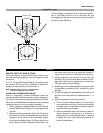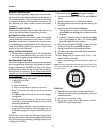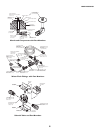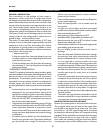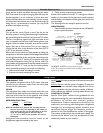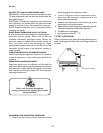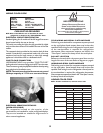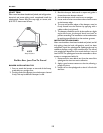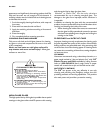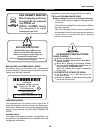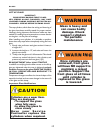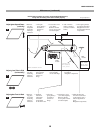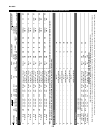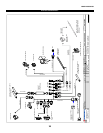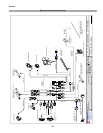
IGSV-ASCS-0303
14
User Information
STOCKING
Improper temperature and lighting will cause serious
product loss. Discoloration, dehydration and spoilage can
be controlled with proper use of the equipment and
handling of product. Product temperature should always
be maintained at a constant and proper temperature. This
means that from the time the product is received, through
storage, preparation and display, the temperature of the
product must be controlled to maximize life of the product.
Hussmann cases were not designed to “heat up” or “cool
down” product—but rather to maintain an item’s proper
temperature for maximum shelf life. To achieve the
protection required always:
1. Minimize processing time to avoid damaging
temperature rise to the product. Product should be at
proper temperature.
2. Keep the air in and around the case area free of foreign
gasses and fumes or food will rapidly deteriorate.
3. Maintain the display merchandisers temperature
controls as outlined in the refrigerator section of this
manual.
4. Do not place any product into these refrigerators until
all controls have been adjusted and they are operating
at the proper temperature. Allow merchandiser to
operate a minimum of six (6) hours before stocking
with any product.
5. When stocking, never allow the product to extend
beyond the recommended load limit. Air discharge
and return air flue must be unobstructed at all
times to provide proper refrigeration.
6. There are vents located at the base of the front of the
glass, just above the front rail. These vents supply a
continuous, gentle flow of air across the front glass
which inhibits condensation. Do not place any
signs or other restrictive objects on the front of
the refrigerator that will block these vents.
7. Keep the service doors closed (when applicable).
Refrigeration performance will be seriously affected
if left open for a prolonged period of time.
8. Avoid the use of supplemental flood or spot lighting.
Display light intensity has been designed for maximum
visibility and product life at the factory. The use of
higher output fluorescent lamps (H.O. and V.H.O.), will
shorten the shelf life of the product.
9. In the Deli, Meat and Fish cases, completely cover the
product each night with a clean damp cloth or butcher
paper (never use plastic, as it does not allow for
proper circulation). Make sure the cloth or paper is in
direct contact with the product.
10. Turn and rotate the meat fairly often. The blood which
gives the pink color works its way downward with
time.
11. Cold coils remove heat and moisture from the case
and deposit this as frost onto the coil. Thus, a defrost
is required. Our humidity system induces moisture
into the case and helps slow down the dehydration
process. The only other moisture within the case is
that in the product itself. A single level of meat will dry
out faster than a fully loaded case of 3–4 levels of meat.
IMPORTANT STEPS
1. Do not set temperature too cold, as this causes
product dehydration. Product Temperature: 33°–
35°! Set thermostat to cut in at 28° discharge air. Meat
holding box: 32°. Meat prep room: 55°. Meat bloom
box: 36°. Process the meat to enter case at 40° or
below. Product deterioration is very rapid above 40°.
2. Temperature control should be by means of a T-Stat
and Suction Stop Solenoid at each case. DO NOT use
EPR valves, Liquid line solenoids or electronic control
devices of any kind, as these allow temperature swings
causing dehydration and excessive energy
consumption.
3. Product should be worked and rotated on a regular
basis, not to exceed a 4 hour period.
4. At night, turn off case lights and cover the product
with a damp (not wet) cloth similar to cheese cloth
(etc.). This should be washed out in the morning and
kept in a walk-in box during the day—so that it is cool
and moist when covering the product.
5. Discharge air temperature should be approximately
26°F, with between 150-200 FPM air velocity. Do not
display product directly within the air discharge.
6. Clean humidity system a minimum of every 90 days for
proper system operation.
CASE CLEANING
Long life and satisfactory performance of any equipment
are dependent upon the care given to it. To insure long life,
proper sanitation and minimum maintenance costs, the
refrigerator should be thoroughly cleaned frequently. SHUT
OFF FAN DURING CLEANING PROCESS. It can be
unplugged within the case, or shut off entire case at the
source. The interior bottom may be cleaned with any
domestic soap or detergent based cleaners. Sanitizing
solutions will not harm the interior bottom, however, these
solutions should always be used according to the
Hussmann’s directions. It is essential to establish and
regulate cleaning procedures. This will minimize bacteria
causing discoloration which leads to degraded product



